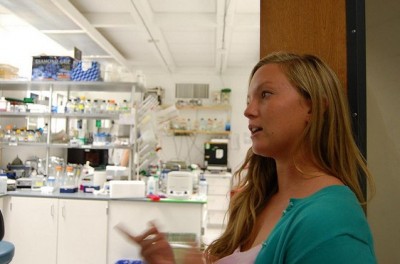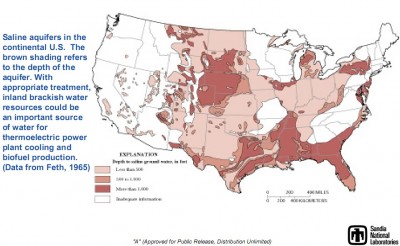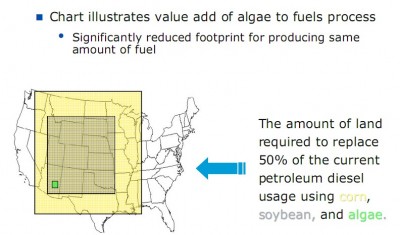Dec
6
The Biomass Algae Research Target Is Shifting to Seaweed
December 6, 2010 | 9 Comments
It’s coming – research interest is moving toward seaweed from algae. For algae enthusiasts, keep in mind that technically speaking common algae is micro algae and seaweed is macro algae. They both offer a huge advantage to other plants in line for fuel production.
These two life forms offer efficiency; they grow without using energy to make cellulose, the land plant’s answer to structure for gravity, wind and animal assaults. For comparison algae are thought to produce 50% of the O2 while they’re less than 1% of the total plant biomass on Earth. That said, adding seaweed or macro algae to the biomass for fuel effort would seem inevitable.
Last week Al Fin spotted Joanna Schroeder’s article at domesticfuel.com. It seems Ms. Schroeder talked with B. Greg Mitchell at the Scripps Institution of Oceanography at the University of California San Diego (UCSD-SIO). Mitchell’s perspective as reported by Schroeder is worth some review.
The Scripps Institute has been researching seaweed for more than 40 years. It’s safe to assume that just as everyone else, the Scripps Institute seaweed to fuel research hasn’t been front and center for the whole 40 years. But Mitchell, who as late as 2 years ago, was discussing micro algae in detail.
Schroeder reports Mitchell now believes the research into seaweed will be well rewarded in the benefits it would provide the country including offering solutions for energy security, hunger, water use, land use, biodiversity, and climate.
Seaweed has potential for very high yields and high oil production while thriving on non-arable land. Another benefit is that they grow well in salt water. Traditionally crops will not excel in salt water if they survive at all, and in some areas of the country valuable agricultural land has been taken out of production due to high concentrations of salt.
But as all biology researchers know, not all macro algae strains are created equal. There are strains of seaweeds that hold great promise for bio-energy and others that hold great promise for producing other products such as high protein meals for replacing non-sustainable ocean-caught fishmeals in aquaculture and other animal diets.
For example, there are strains of seaweeds that UCSD-SIO has been studying that grow well inland and can be used to recycle artificial seawater and waste nutrients from chicken ranches or pig farms. Algae has also been used in farm fish operations from cleaning the ponds to providing feed.
Now to the key points. Mitchell believes that the key to research lies in the lifecycle of the seaweed, especially its sexual phases, “The lifecycle including sexual phases are better known and more easily controlled for some seaweeds,” explained Mitchell. “That may make it easier to breed/hybridize using traditional Mendelian genetics. All companies are looking at how to use classical recombinant methods.” Mendelian genetics focuses on natural recombination rather than human induced modification and since Mendelian genetics focuses on a natural process, the products created from the research will not have the regulatory issues that have hindered the development of algae products created by genetically modified strains.
Still, whether micro algae or macro algae there are the same problems to solve for commercialization. Costs of production have to come way way down, the best strains of seaweed need to identified and optimized, and testing of the strains needs expanded. Scale has to increase to hundreds of acres rather than small tests. Water has to be removed and oil and useful products taken out. This is just a wee bit of the challenges.
But the results could be astonishing. The area needed for micro algae production is much less than land plants and macro algae is even more productive. The land issue isn’t in fact of much note, and saline water is available across wide tracts of the U.S in addition to ocean water.
Mitchell thinks the timeline will shorten up, with major developments in 10 years. So far all the research is small lab work and needs taken to commercial scale. “We need several hundred acre demos that would take three years to design, permit and build. Then we need at least two years to get data and improve design,” said Mitchell. “Then we’ll roll out commercial scale over the following five years. We can do all this now at pilot scale but its not yet economically viable. So I see 10 years for this to be turned to economic viability.”
Many first impressions of seaweed farming suggest a plot at sea, but seaweed is one species that should be able to grow inland with proper facilities and management. As the maps above show the potential is huge and the needed area quite small. It’s research well worth the effort.
Comments
9 Comments so far





I enjoyed the graphic of the relative land area needed to replace 50% of diesel using corn, soybean, or algae. The time required to reach that point — using algae — will likely be about 15 or 20 years, depending on effort invested.
Chemicals and fuels from the biomass of algae (both micro and macro) could easily precede any large scale oils from algae production due to the prolific biomass and the advancing of gasification, pyrolysis, and catalytic synthesis techniques by Huber and others. Thermochemical approaches can be scaled up quickly, if the biomass supply is abundant and reliable. That approach could beat oils-from-algae scale-up by ten years or more.
No magic bullets, nor a single approach tat suits all. Vast potential, so as Obama says “spread the wealth around.”
It’s also of interest to note that certain seaweeds are excellent at removing heavy metals from water. Japanese researchers are working on strains optimized to extract Uranium from sea water – and perhaps even gold.
40 years from now – sea water may be mined for important metals simply by growing seaweed.
Other water plants should be consider as duckweed,water hiacinthya. They remmediate waters and outproduce land crops. Duckweeds specially, are high in proteins like soy and very efficient water cleaner.
I REALLY liked your post and blog! It took me a minute bit to find your site…but I bookmarked it. Would you mind if I posted a link back to your post?
Fantastic article! I got to know about macro algae called seaweed from this article. Thanks
i liked your post about algae research… thnx for sharinf
I loved this article on biomass algae. Most useful page on the entire web for this topic. Thanks
This post about algae is really interesting, Ill add this to my bookmarked pages.
Never realized that seaweed farming was doable in the US. I think I’ll dive into this more deeper. Great post btw.